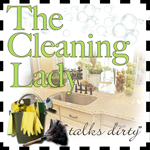Yea Bleach!!! Bleach often saves the day, makes a tough stain disappear and makes a long job into a quick fix. Yea Bleach.
Lets talk about the properties of bleach (briefly). Bleach is a chemical -- it is featured on the Periodic Table of Elements -- let's NOT go there... 'k. Good.
For our purposes, here is what we need to know about bleach -- it serves three functions:
1. Bleach whitens.
2. Bleach disinfects (kills germs).
3. Oxidizes metals
In the above photo you will see my three favorite forms of bleach -- household laundry bleach, bleach infused in a cleanser, like Comet, and a super concentrated bleach in the bathroom cleaner, Tilex..
When we are cleaning with bleach we need to be particularly careful to not mix bleach with other chemicals -- doing so can be dangerous and deadly. (I am far from an alarmist -- I think the world is far better off with a lot less Nerf... but I will say this, use bleach with caution.)
Assuming we are going to play nice and not mix bleach with other chemicals, like ammonia or CLR... let's talk about the fabulous things bleach can do for you:
Before we go on, lets be clear -- bleach does NOT CLEAN ANYTHING. It does not cut grime, it does not wash away dirt. It bleaches. It sanitizes. It deodorizes. But it does NOT clean anything. If your stove is dirty, bleach will not help you. If the floor is filthy, pass bleach on by. What it does do it does great, but bleach does NOT clean.
Bleach sanitizes, deodorizes, whitens, brightens fabrics, metals and water surfaces, such as sheets, towels, socks, toilets, sinks, tubs, bottles, toys, bird baths, ice chests, refrigerator seals... The list goes on. If you need to kill mold, mildew or algae, bleach is your weapon. If you need to remove dyes and stains from linens and clothing, assuming they are white, bleach is the best thing going.
Bleach is NOT great for all white clothing -- it will yellow polyester and cause white Rayon to go gray. Use only on natural fibers -- cotton, wool, linen, ramie -- and only sparingly.
To use in the home -- pour a 1/2 cup on bleach in the toilet, top with a sprinkle of Comet and leave sit for 10 minutes of so.
For an odor coming from a kitchen sink, bath tub or shower drain, pour a 1/2 cup down the drain AFTER thoroughly cleaning with such products as Comet or ammonia or CLR and giving a thorough rinse . You may need to resort to bigger guns -- like a drain cleaner or a plumber, but a 1/2 cup of bleach is a good place to start.
In and around bath and kitchen sink drains, remove the stopper, if you dare. Remove the stopper in the bathroom (sometimes easier said than done). If you can remove it you might see that it is black from top to bottom. This is common mold -- and it's icky. I like to set such a mold covered item in a ceramic bowl, cover with water and add a 1/2 cup of bleach -- leave it sit for several minutes to several hours. You may need to scrub with a cleanser and a tooth brush. (I do this while the water is running it's not quite so ooky!)
Now take a look at the rubber gasket in the garbage disposal. If it's never been cleaned, beware -- not for the squeamish. Most kitchen sink odors are the result of mold infused drains and gaskets. I clean these gaskets using a bleach cleanser (Comet/Ajax, on a textured scrubber -- Scotch Brite) with the water slightly running. Scrub, rinse, scrub, rinse.
Additionally, in the kitchen, bleach is the best for making coffee and tea stains disappear from pale laminate counters.
Another spot for bleach is the ridged refrigerator seal. Take a look, if it is supposed to be white you might notice that it's very black. Using a paper towel or cotton ball, dip into a bowl of bleach and wipe the seal making sure all the mold is removed as you go.
A better cleaner for that seal is actually vinegar. It not only removes mold faster, but keeps mold from coming back far longer. Vinegar appears to act as a mild bleaching agent -- it is actually an acid, but there we are, back on the Period Table of Elements and we did not want to go there.
While we have a bowl of bleach, soak the kitchen and bath faucets, where the water comes out and wipe with a paper towel or cloth. Don't be surprised to find large pieces of mold floating in the bowl... in warm months especially, faucets are an optimum breeding ground for mold.
If you have ever seen plastic squeeze bathtub toys look black from the inside out, this is mold growing inside. To wage war on the mold and to sanitize plastic toys, fill a sink with hot hot hot water -- add a cup of bleach and dunk in the toys. For the squeaky-type bathtub toys, squeeze the air out, hold under bleach water, release the squeeze (to make water suck into the toy, shake and squeeze to remove the bleach water.
Should your stainless steel flatware start looking dull, dump it in a large bowl or sink filled with hot water and a 1/2 cup of bleach. It takes only a few moments. Submerge the stainless silverware, dump, rinse and dry.
Bleach does wonders with stainless steel -- even refrigerators. If your stainless fridge is looking dull and mottled, spray with a bleach solution of 1/2 cup of bleach to a quart of hot water. Wipe dry with a paper towel. It will look brighter, but it won't shine nice. Bleach dries too quickly and leaves a bit of residue. Once the fridge is dry, clean as usual with an ammonia solution or an oil-based fridge cleaner. Your fridge will glisten!
For plastic storage containers that have acquired a stain or an odor, try bleach. 1/2 cup bleach to ever quart of water -- and here's a tip -- squirt a bit of acidic (lemon) dish detergent. You will see the detergent foam up almost immediately -- it will also get hot and clean the plastic better. (red food stains, such as tomato may be permanent).
To sanitize water, to be safe for drinking, assuming you get stuck miles and miles from the nearest sanitary tap or bottle of water, you need very little bleach to make your water clean and safe. 1 part bleach to 100 parts water.
Bleach is essential for cleaning a house -- for killing mold, whitening stains, sanitizing surfaces. Use it -- a little goes a long long way!
Tuesday, July 26, 2011
Subscribe to:
Post Comments (Atom)












Helpful info... many thanks!
ReplyDeleteGreat details... Thanks!
ReplyDeleteI know you posted this a longggggg time ago, but I am very happy I stumbled upon your blog. I'm half German as well, and was taught to clean & do chores since I was little girl; now I'm 30 years (young) and pretty OCD when it comes to germs. My main "go-to" products are bleach, cleaning ammonia & vinegar, pine-sol, and CLR. That's not ALL of them, that's just the ones I cannot absolutely live without! I loved your blog about ammonia because I use it for everything, and it really is a great versatile household cleaner if you know what your doing...and dilute it lol. I do find that my eyes are bloodshot sometimes if I've been scrubbing with it too long (sometimes I do get carried away). One thing I do with bleach is wash my walls with them, and everyone tells me not to do it because it can hurt the paint? It's a simple process, I use a disposable washcloth and water-bleach mixture & go around my apartment wiping down the walls lol. They are white, so I don't see how it can hurt? I'm only doing it 2x a month, and It's more of a sanitizing purpose. Do you think it's ok?
ReplyDeleteشركة تنظيف بالجبيل
ReplyDeletePalmacedar Cleaning Limited is one of the best general cleaning and janitorial service company in Lagos,Nigeria. We are are experts in cleaning, janitorial and fumigation services.
ReplyDelete